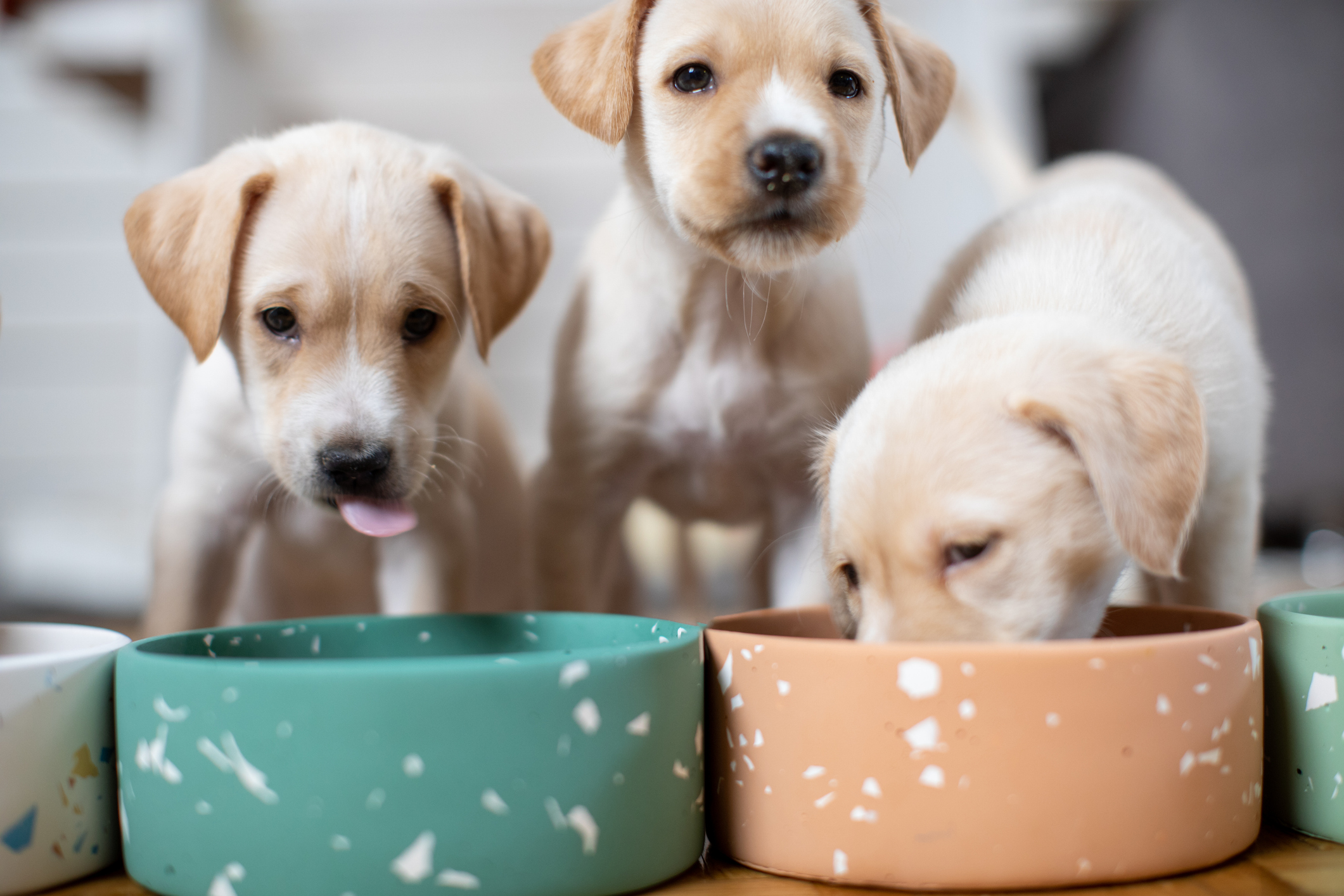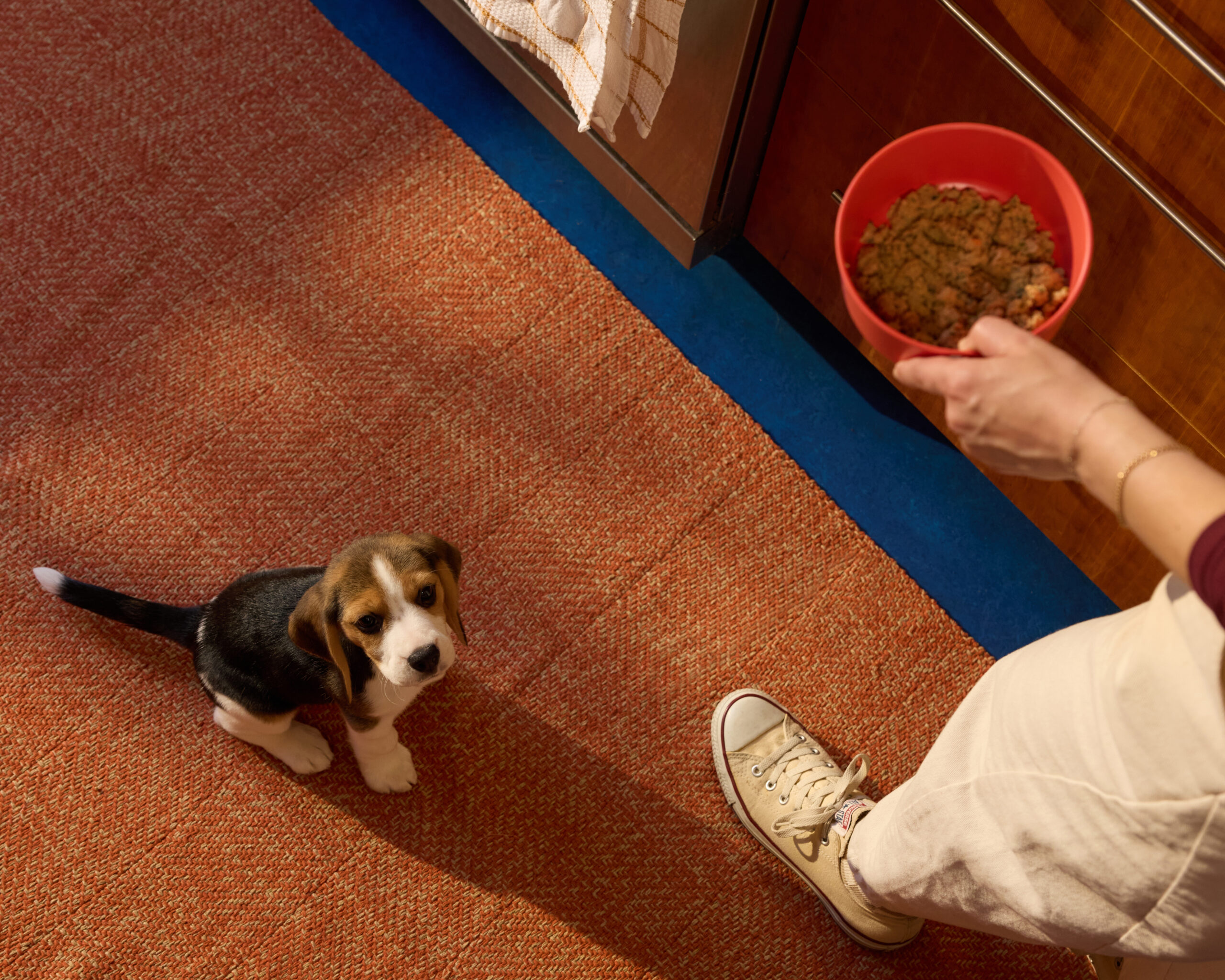Hey Ollie blog readers! We’re offering you an exclusive 60% OFF your starter box! Try now!
Your puppy’s life is full of milestones such as their first veterinary visit, obedience school graduation, and the day they stop chewing your shoes. As your puppy grows into a lanky adolescent, you may wonder about other significant life events, including how long should you feed them puppy food. In this article, we’ll explore the general guidelines on how long puppies should be fed puppy food and provide insider tips on how to successfully switch your dog’s food.
Signs It’s Time to Switch Your Puppy to Dog Food
When your puppy reaches major milestones, your veterinarian is the best resource for personalized recommendations. Between vet visits, here are some ways to recognize that your pup has achieved adult dog status.
Age and Size
In general, most puppies are ready to graduate to dog food when they reach 80% of their expected adult size. Most dogs achieve this point by 12 months of age but large- and giant-breed dogs may take up to 18 months or longer to reach full physical maturity. If your puppy is a mixed breed, your veterinarian can help you estimate their adult height and weight.
Physical Signs of Maturity
As dogs mature, their bodies undergo significant physical changes. Look for these changes in your puppy’s body:
- Loss of the signature “puppy belly” and an increase in lean muscle mass
- Increased chest depth and width
- Cessation of height growth
- Changes in ear or tail carriage
- Changes in haircoat. In some breeds, fine or fluffy puppy hair is replaced by a coarse or thick coat. Coat color change may also occur in some breeds.
- Balanced proportions. Puppies appear to “grow into” their big feet, long limbs, or floppy ears.
Note: Many physical attributes are controlled by a dog’s sex hormones. As such, puppies who are spayed or neutered early may not display all of the listed features, and therefore physical attributes shouldn’t be used as the sole indicator for when to switch a puppy to adult food.
Energy Levels
Although it may not seem like it during the peak of puppyhood, most adolescent dogs’ energy levels decrease once they reach maturity. While adult dogs will generally maintain appropriate enthusiasm and energy for physical activity, exercise, and the occasional zoomies, they may appear less excitable or rambunctious about everyday happenings. Owners may notice that their dog seems calmer, more relaxed, or content in their surroundings and more focused and attentive during training.
Decreased energy levels may coincide with decreased metabolism and caloric needs, especially if your dog has been spayed or neutered. As such, this may be an appropriate time to switch your puppy to adult food to prevent undesirable weight gain and weight-related health conditions.

Dental Development
Puppies have 28 deciduous or baby teeth that they begin losing when they are 12 weeks old. These teeth loosen and fall out during the next three months and are replaced by larger, more deeply rooted adult teeth. By the time most dogs are 6 months old, all permanent teeth have erupted. When looking in your dog’s mouth, you will be able to see the difference in tooth size and sharpness, indicating whether they have mostly deciduous or adult teeth. While dogs use their teeth to rip and tear rather than grind and chew, full adult dentition can suggest that a small- to medium-sized dog has reached maturity, and your puppy is ready to switch to dog food.
Veterinarian Recommendation
As previously mentioned, your veterinarian is the ultimate resource for insights on your puppy’s development and nutrition and can help you understand how long to feed your pup puppy food. Remember, what you feed your puppy isn’t merely filling their stomach, it’s fueling their growth, cognitive development, and health. Take the time to do your own research and seek veterinary guidance to ensure any diet change is not only appropriate for your dog’s current life stage but their present and future wellness.
Steps to Transition Your Puppy To Adult Dog Food
Watching your puppy grow from a tottering ball of fluff to a sleek and graceful adult is a beautiful process, but it doesn’t happen overnight. Your puppy’s transition to adult dog food shouldn’t either. Abrupt transitions and cold-turkey changes can disrupt your young dog’s digestive tract and cause unfortunate complications such as diarrhea, loose stool, and gas. Set up your newly minted adult dog for success by phasing in the new food in a gradual, controlled manner.
Step 1: Talk to Your Vet
In addition to advising you on when to switch your puppy to adult food, your veterinarian can provide personalized guidance. Your vet will help you determine important details about the type and amount of dog food you should provide your pup such as:
- Determining your dog’s daily caloric requirement (i.e., portion size)
- Demonstrating how to assess your dog’s body condition and to adjust their feeding regimen
- How to select the right dog food
- When and how often to feed your dog
- What to do if your pup doesn’t like or tolerate their new food
Step 2: Choose the Right Dog Food
While dog foods are available in various quality levels, no one perfect food exists for every dog. Selecting the best food for your dog will require careful consideration regarding their health, breed, activity level, and preferences, as well as your budget. Here’s a close look at how to choose the right food for your dog.
Step 3: Start Mixing Puppy Food and Adult Dog Food
Over 7 to 10 days, begin incorporating increasingly larger amounts of adult dog food into your pup’s meals, replacing portions of puppy food with the adult food. Begin with 25% adult dog food and 75% puppy food. If your puppy has a sensitive stomach, start with a smaller portion of new food and gradually work up to 25%.
Step 4: Gradually Increase Adult Dog Food
As long as your puppy is eating well and not experiencing any gastrointestinal upset, proceed with increasing the new food and decreasing the old food to achieve a 50/50 ratio.
Step 5: Shift the Balance
Begin feeding 75% adult dog food and 25% puppy food.
Step 6: Fully Transition to Adult Dog Food
You did it! Begin feeding your grown-up pup 100% adult dog food. But before you get too nostalgic for your cuddly puppy, remember, no matter their age, a dog is always a puppy at heart!
Vet Answers the Most Common Questions about Transitioning Dog Food
Remember to monitor your dog’s appetite, energy, and poop throughout the transition process. Their behavior will tell you whether to continue increasing the specific portion of adult dog food they are currently receiving. If you notice loose stool, gas, lethargy, or any other concerning signs, return to the previous portion size and increase the amount of dog food more gradually.
Ollie’s Fresh Dog Food Is Safe For All Ages
Puppyhood is filled with daily challenges and can leave you feeling like you’re both chasing your tails. Let Ollie eliminate your concerns about what, when, and how much to feed your growing pup. Our all-life-stages dog food recipes are uniquely formulated to deliver complete, balanced, and appropriate nutrition for puppies and adults alike. That means when you feed your dog Ollie, you won’t have to worry about timing your pup’s transition—making more time for the important things, like enjoying the last moments of puppyhood before they slip away.
But lest you get too sad, those chew marks on your shoes will last forever.
Try Ollie today and simplify your feeding routine!
The Ollie blog is devoted to helping pet parents lead healthier lives with their pups. If you want to learn more about our fresh, human-grade food, check out MyOllie.com.
Tagged As:

The nutrition your dog needs,
the food they want.

Enjoying our articles? Subscribe our Newsletters and get new articles directly to your inbox
You might also like
9 October 2025
5 MINS READ
Thrive From Day One: Choosing the Healthiest Food for Your New Puppy
As you welcome your new furry family member, one of the most impactful choices you’ll make is what to put in their food bowl. Providing the right nutrition from the start is the foundation for a l…
by Ollie Pets
9 October 2025
5 MINS READ
Should Your Dog Switch to Fresh Food?
As a pup parent, you’re always looking for ways to help your dog live the happiest, healthiest life possible. You’ve likely heard the buzz around fresh dog food, but what does it really mean? Mo…
by Ollie Pets
9 October 2025
6 MINS READ
Beyond Kibble: Fresh Food Alternatives for Your Dog’s Health
For a long time, dry kibble has been the default, but more and more pup parents are starting to wonder if it’s really the best option for their dogs. The good news is that there are many dog food …
by Ollie Pets







